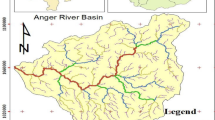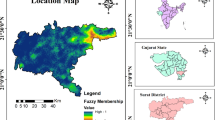Abstract
A new hydro-tectonic model, includes eight layers that affect karst hydrogeology was proposed for mapping of groundwater potential in karst areas of Gurpi Anticline, southwest Iran. To produce the groundwater potential map, remote sensing (RS) and GIS techniques were combined with fuzzy logic modeling. Criterion maps include the distances from discharge sites (D), the elevation difference from discharge sites (E), the distance from fractures (F), the fracture length density (L), the slope (O), the lithology (G), the distance from fractures intersections (I), and the fractures intersection density (C) were produced using GIS and RS techniques (DEFLOGIC layers). The approach of fuzzy sets was used to commensurate criterion maps, then fuzzy algebraic sum and gamma operators were applied to aggregate them. The weights of parameters of DEFLOGIC proposed in the range of 1 to 5, which standardized between 0 to 1, based on their importance in karst hydrogeology, professional judgments, and available exploration data. The final groundwater potential maps were verified by geoelectric and well-drilling data. The potential map prepared using fuzzy gamma operator with γ = 0.92, which it is a flexible distinctive parameters of sum and product of fuzzy operator, depicts the best coincidence with exploration data. The final DEFLOGIC map shows the high groundwater potential in karst formations between Hati and Pebde valleys. The results support the efficiency of DEFLOGIC model to evaluating of groundwater potential in karst terrains, especially in Zagros ranges.














Similar content being viewed by others
References
Carter B, Graem F (1991) Geographic information system for geoscientists: modelling with GIS. Pergamon, Ontario, pp 319–470
Combettes PL (1993) The foundations of set theoretic estimation. Proc IEEE 81(2):182–208
Cowen D (1988) CAD versus DBMS: what are the differences? Photogramm Eng Remote Sens 54(2):1551–1555
Degnan JR, Clarck SF (2002) Fracture-correlated lineaments at Great Bay, Southeastern New Hampshire. U.S. Geological Survey, Open File-Report 02–13
Dubois D, Prade H (1985) A review of fuzzy set aggregation connectives. Inform Sci 36:85–121
Hoffmann J, Sander P (2007) Remote sensing and GIS in hydrogeology. Hydrogeol J 15(1):29–32
Israil M, Al-hadithi M, Singhal DC (2006) Application of a resistivity survey and geographical information system (GIS) analysis for hydrogeological zoning of a piedmont area, Himalayan foothill region, India. Hydrogeol J 14(5):753–759
Jaiswal RK, Mukherjee S, Krishnamurthy J, Saxena R (2003) Role of remote sensing and GIS techniques for generation of groundwater prospect zones towards rural development—an approach. Int J Remote Sens 24(5):993–1008
Lattman LH, Parizek RR (1964) Relationship between fracture traces and the occurrence of groundwater in carbonate rocks. J Hydrol 2:73–91
Lattmann LH (1958) Techniques of mapping geologic fracture traces and lineaments on aerial photographs. Photogr Eng 24:568–576
Mabee SB, Hardcastle KC, Wise DW (1994) A method for collecting and analyzing lineaments for regional-scale fractured bedrock aquifer studies. Ground Water 32(6):884–894
Malczewski J (1999) GIS and multicriteria decision analysis: evaluation criteria and criterion weighting. Wiley, Hoboken. pp: 103–195
Ravi Shankar MN, Mohan G (2006) Assessment of the groundwater potential and quality in Bhatsa and Kalu river basins of Thane district, western Deccan Volcanic Province of India. J Environ Geol 49(7):990–998
Sener E, Davraz A, Ozcelik M (2005) An integration of GIS and remote sensing in groundwater investigations: a case study in Burdur, Turkey. Hydrogeol J 13(5–6):826–834
Shahid S, Nath SK, Roy J (2000) Groundwater potential modelling in a soft rock area using a GIS. Int J Remote Sens 21(9):1919–1924
Srivastava PK, Bhatacharya A (2006) Groundwater assessment through an integrated approach using remote sensing, GIS and resistivity techniques: a case study from a hard rock terrain. Int J Remote Sens 27(20):4599–4620
Subba Rao N (2006) Groundwater potential index in a crystalline terrain using remote sensing data. J Environ Geol 50(7):1067–1076
Tam VT, De Smedt F, Batelaan O, Dassargues A (2004) Study on the relationship between lineaments and borehole specific capacity in a fractured and karstified limestone area in Vietnam. Hydrogeol J 12(6):662–673
Trillas E, Alsina C, Valverda L (1983) On some logical connectives for fuzzy set theory. J Math Anal Appl 93:15–26
White WB (1988) Geomorphology and hydrology of Karst terrains. Oxford
Yager RR, Kelman A (1996) Fusion of fuzzy information with considerations for compatibility, partial aggregation, and reinforcement. Int J Approx Reason 15(2):93–122
Yager RR (1977) Multiple objective decisions making using fuzzy sets. Int J Man–Mach Stud 9:375–382
Yager RR (1991) Connectives and quantifiers in fuzzy sets. Fuzzy Set Syst 40:39–75
Zadeh LA (1978) Fuzzy sets as a basis for theory of possibility. Fuzzy Set Syst 1(1):3–28
Author information
Authors and Affiliations
Corresponding author
Rights and permissions
About this article
Cite this article
Mohammadi, Z., Alijani, F. & Rangzan, K. DEFLOGIC: a method for assessment of groundwater potential in karst terrains: Gurpi Anticline, southwest Iran. Arab J Geosci 7, 3639–3655 (2014). https://doi.org/10.1007/s12517-013-0958-6
Received:
Accepted:
Published:
Issue Date:
DOI: https://doi.org/10.1007/s12517-013-0958-6




